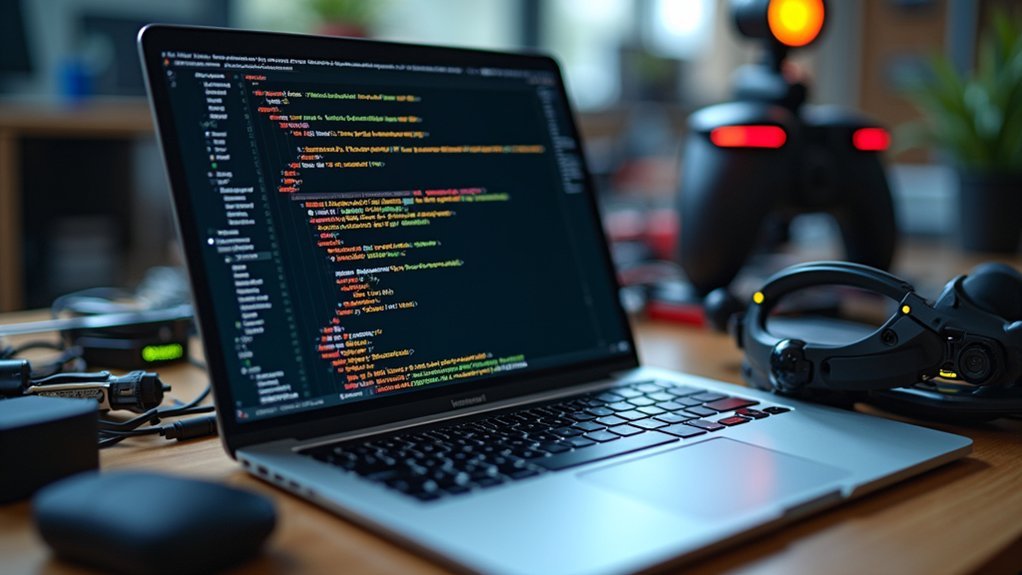You’ll need to verify your AR SDK version aligns with minimum Android requirements and update dependencies regularly to fix bugs. Implement thorough device testing across various brands and OS versions while checking ARCore’s official compatibility list. Configure your build.gradle settings properly, specifying correct SDK versions and monitoring for dependency conflicts. Establish fallback mechanisms for unsupported devices with clear messaging and alternative functionalities. Monitor performance metrics continuously using profiling tools like Android Profiler to optimize memory usage and frame rates across different specifications for deeper insights ahead.
Verify SDK Version Compatibility and Update Dependencies

Since AR applications rely heavily on precise SDK interactions, you must first verify that your AR SDK version aligns with your application’s minimum Android SDK requirements. Mismatched versions create functionality issues that’ll compromise your app’s performance.
Start by checking your AR SDK documentation for specific compatibility requirements, then cross-reference these with your project’s target API levels.
Next, update dependencies regularly to maintain peak performance. The BytePlus Effects SDK frequently releases updates containing critical bug fixes and performance enhancements.
Review your build.gradle file carefully to identify conflicting library versions that could trigger compatibility issues. Remove any outdated dependencies and confirm all required libraries are properly included.
This proactive approach to dependency management prevents many common AR SDK compatibility problems before they impact your users’ experience.
Implement Comprehensive Device Testing Across Android Versions
After establishing proper SDK compatibility, you’ll need to implement systematic testing across multiple Android devices and versions to confirm your AR application performs consistently.
This thorough approach guarantees your AR development process addresses compatibility issues before they impact user engagement.
Your testing strategy should include:
- Device diversity testing – Test across various Android brands, models, and OS versions using both emulators and physical devices
- ARCore compatibility verification – Regularly check the official device compatibility list to confirm your SDK supports targeted devices
- Beta testing feedback – Leverage user insights to identify device-specific performance issues requiring technical expertise
- Performance monitoring – Implement real-time logging to track AR feature performance and identify rendering inconsistencies
- Systematic documentation – Record compatibility findings to streamline future development cycles
Configure Build.Gradle Settings for Optimal AR Performance

Testing reveals compatibility issues, but proper `build.gradle` configuration prevents many of these problems from occurring in the first place.
You’ll need to specify the correct SDK version dependencies that align with your AR SDK’s minimum requirements, whether you’re using BytePlus Effects SDK or ARCore. Always use the latest AR SDK version and update dependencies regularly to avoid performance bottlenecks across different Android versions.
Monitor your `build.gradle` for dependency conflicts that can cause integration problems and inconsistent performance. These conflicts often create compatibility issues that’re difficult to troubleshoot later.
Additionally, verify your `AndroidManifest.xml` includes proper camera permissions for AR functionality. Regular dependency management and thorough testing on various device configurations will guarantee your application meets the compatibility standards outlined in your SDK documentation.
Establish Fallback Mechanisms for Unsupported Devices
While robust `build.gradle` configuration prevents many compatibility issues, you’ll still encounter devices that can’t support AR functionality due to hardware limitations or outdated operating systems.
Implementing effective fallback mechanisms guarantees you don’t lose users when their devices can’t handle AR features.
Smart fallback strategies ensure every user stays engaged, regardless of their device’s AR capabilities or technical limitations.
- Device detection logic – Automatically identify unsupported devices and switch to non-AR modes or lightweight app versions
- Clear messaging – Inform users about AR feature availability upfront to set proper expectations
- Cloud-based AR solutions – Offload processing through streaming technologies for lower-specification phones
- Alternative functionalities – Offer simplified versions that maintain core app functionality without AR
- Regular updates – Continuously improve fallback mechanisms based on user feedback and compatibility trends
These strategies maintain engaging user experiences across all device types.
Monitor Performance Metrics and Memory Optimization

Performance bottlenecks can quickly transform an impressive AR experience into a frustrating user nightmare.
You’ll need to continuously monitor performance metrics like frame rate, memory usage, and CPU load to identify issues before they impact users. Your AR app requires memory optimization techniques such as object pooling and texture atlasing to reduce consumption and maintain smooth operation.
Leverage profiling tools that your SDK provides, including Android Profiler, to gain detailed insights into resource usage patterns.
Test your AR functionalities across different device specifications and feature complexity levels to guarantee consistent performance. You must analyze real-time rendering and spatial mapping impacts on device performance, allowing you to fine-tune experiences and prevent degradation on lower-end devices while maintaining compatibility standards.
Frequently Asked Questions
How Do I Handle AR SDK Licensing Costs for Commercial Applications?
You’ll need to budget for SDK licensing fees, which vary by platform and usage scale. Consider revenue-sharing models, evaluate free alternatives, negotiate enterprise deals, and factor costs into your app’s pricing strategy early.
Which AR Frameworks Work Best With Cross-Platform Development Tools Like Unity?
You’ll find ARCore, ARKit, and Vuforia integrate seamlessly with Unity’s cross-platform capabilities. They’re specifically designed for Unity development, offering native support, extensive documentation, and streamlined deployment across iOS and Android devices efficiently.
Can I Use Multiple AR SDKS Simultaneously in One Application?
You can technically use multiple AR SDKs simultaneously, but you’ll face significant compatibility conflicts, resource competition, and performance issues. It’s better to choose one primary SDK and integrate specific features from others when absolutely necessary.
What ARe the Data Privacy Implications of Using Cloud-Based AR Features?
You’ll face significant privacy risks when using cloud-based AR features. Your camera data, location information, and biometric details get transmitted to remote servers, potentially exposing sensitive personal information to unauthorized access.
How Do I Migrate From One AR SDK to Another Without Losing Functionality?
You’ll need to audit existing features, map equivalent APIs between SDKs, create abstraction layers for core functions, test thoroughly in stages, and maintain backup builds during changeover to preserve functionality.





Leave a Reply